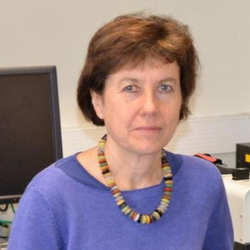Professor Sarah Bray
From stem cells to tissues: Notch regulatory dynamics in development and disease
Affiliation: Department of Physiology, Development and Neuroscience
Research
To make and organize different tissues, cells must decipher information from developmental signalling pathways. Currently we know little about how the information is encoded and decoded, to generate the right balance and arrangements of cell types. Cells face the challenge of transmitting this information accurately, so that cell-surface signals are translated into correct transcriptional responses. How this is achieved mechanistically remains a major question.
The Notch pathway is one of a small handful of cell signalling pathways that coordinate animal development, regulating the types and numbers of cells formed in many developmental contexts. Its roles include the maintenance of stem cell/progenitor populations, a requirement that continues during tissue homeostasis in the adult. Aberrant Notch function is also implicated in many diseases including dementia and many cancers. Discovering how the appropriate responses to Notch are configured is therefore vital for deciphering when combinations of genetic abnormalities are likely to be oncogenic, and for informing strategies for targeted therapies.
Bray's research uses a combination of live-imaging, genetic, biochemical and genomic approaches in Drosophila and in human cells to discover the fundamental mechanisms that reset and sculpt transcriptional responses to Notch. These mechanisms are essential to bring about different outcomes and to avoid inappropriate gene expression programmes being turned on.
Bray's lab is currently investigating the following questions:
- How are Notch signals decoded by enhancers in real time in vivo?
- What epigenetic mechanisms reset transcriptional responses to Notch during cell state transitions?
- How do Notch regulated enhancers select and communicate with promoters?
- What roles tissue geometry and forces play in shaping signalling dynamics?


